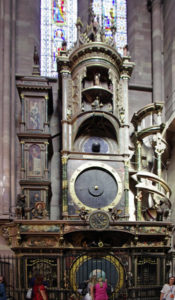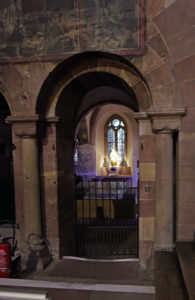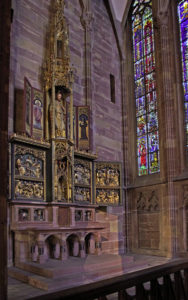When it was built, this was the tallest building in the world and it is still the sixth tallest church. The cathedral with its spire towers over the city. The best view is from Rue Merciere, with the rose window and carved west doorway.
Although started in 1015, all that remains of the Roman church is the east end as the rest was destroyed in a fire. The rest of the church is C13th and was built in the new Gothic style with the west end dating from the C14th. It is regarded as one of the best examples of late Gothic architecture with its flying buttresses crocketted pinnacles and carvings. The west front is particularly impressive with its three doorways. Each is surrounded by statues and the Tympanum above the doorways show the childhood of Christ, the Crucifixion and the Last Judgement.
Inside arcades with pointed arches and colourful stained glass windows in the clerestory separate the nave from the side aisles. The pillars soar upwards to form the ribs of the vaulted ceiling.
The medieval stained glass is one of the glories of the cathedral and sunlight streaming in through the windows fills the cathedral with colour. These were removed from the cathedral during the Second World war and stored in a salt mine. Hitler gave orders for them to be destroyed but fortunately the Americans managed to stop the destruction. The rose window at the west end is glorious.
At the west end is the glorious rose window.
But there’s more to the cathedral than the windows. The brightly painted organ is set high on a pillar on the north arcade and the lovely carved stone pulpit is nearer the crossing.
Steps lead up to the Romanesque chancel apse. The wall paintings are C19th showing scenes from the Old Testament. The small stained glass window was given by the Council of Europe to replace the one destroyed in the Second World War. It depicts the Virgin Mary with the Christ Child on her lap. At the top is the symbol of the European Union with a circle of twelve gold stars on a blue background. Under the chancel is the C11th crypt which was shut when I visited.
In the north transept is the Chapel of St Laurent with its splendid altar and reredos occupying the whole of the east wall. This is reserved for private prayer. Near it is a small altar with a medieval triptych with carvings of St Roch, St Maurice and St Nicholas.
The end of the north aisle is part of the original Romanesque church with its massive round arches.
At the end of the south aisle is the Chapel of St Katherine which was locked. Again it has a splendid reredos, which I had to photograph through the iron grille. Beyond is the Pillar of Angels and the astronomical clock. This is a splendid piece of work, dating from 1571 and is one of the largest in the world. The mechanism had to be replaced in the C19th. As well as telling the time and days of the week, it also shows the phases of the moon and the position of the planets. At 12.30 there is an animated display. An angel rings a bell while a second one turns over the hourglass. Four characters representing the four ages of life (infant, young man, adult and old man) march past Death. Above are the Twelve Apostles who march before Christ, bowing to him. Christ blesses them and the rooster perched on the left tower flaps its wings while crowing three times.
To the left of the clock, steps lead down to the Romanesque chapel of St Andre. Above the round topped doorways is a C15th fresco.
The cathedral is open daily from 10-5.5.30 and from 12.30-6.30 on Sundays. When I visited there was strict security following terrorist bombings in France. Bags were searched as people entered. Seating in the nave was roped off, the crypt and other chapels were locked. I joined the long queue of visitors following a set route through the cathedral.
There are more pictures “here.”:http://wasleys.org.uk/eleanor/otherholidays/rhine/c_strasbourg/cathedral/index.html










